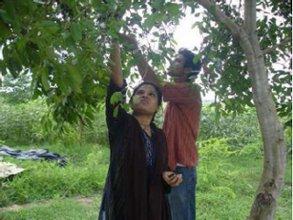Community Managed Food Forest
Community Managed Food Forest

With the degeneration of forests and other ecosystems, income source of poor families have gradually withered away, resulting in acute scarcity of food and malnutrition. Added to their woes, is the extinction of the wide variety of indigenous trees that not only fetched food and fruits (tuber, root, different types of weeds, juice etc) for the rural poor but also provided fodder for the livestock. Condition worsens among the landless and poor families and they are left in a helpless state during and in the aftermath of natural calamities. They are at a higher risk, as they don't have a social or financial backup support system, in order to overcome the adversities of a disaster.
In the food forest model, groups of landless or rural unemployed collectively take available fallow lands on short term lease and plant a wide variety of ecosystamtically suitable multipurpose trees i.e. a judicious combination of various trees, shrubs, creepers/ climbers, grasses, tubers - that acts as a huge food reserve with high tolerance against natural calamities which provide food, fuel and fodder, those that are good for making quality furniture coupled with seasonal production. If there is water body, fish and duck keeping are added options. This model has been successful in warding off the crisis created by disasters and also creates a scope for a supplementary income of the group members from pisciculture, poultry and duckery. At the same time, afforestation by intensive mixed planting would resist global warming, conserve biodiversity on the one hand and will create an asset for the landless.
The food forest was first introduced among the poor and landless families of Khoskadampur village (Gram Panchayat Kankalitala, Block- Bolpur Sriniketan, District Birbhum of West Bengal) in 2004. DRCSC organized landless poor from the community to discuss with the PRI on getting land on condition that revenue generated from the use of land between government and the community at ratio of 25 : 75. The user communities are involved in selecting species, raising, and planting seedlings, protecting the saplings harvesting and distribution of produce. The saplings were protected and nurtured by the group members over the years and they are reaping the fruits and other produces, which is equally shared among the members, especially during and after natural calamities when no other food is available. Vegetables, pulses, oilseeds, etc are also cultivated as inter-crops which not only serve the day today requirements of food of human beings but also meet the fodder need of the livestock. To sustain the efforts, food forest has been integrated with poultry and duckery.
Source : DRCSC newsletter, Issue 6
Last Modified : 2/23/2020
